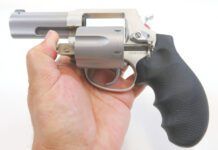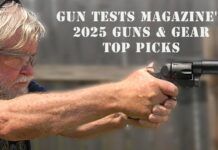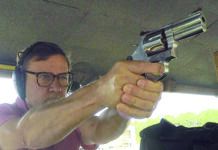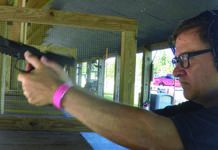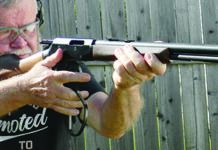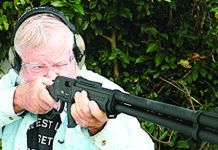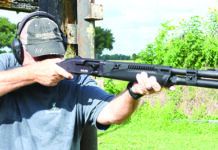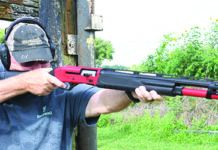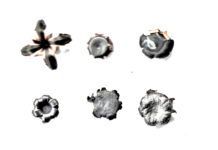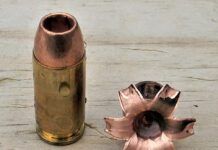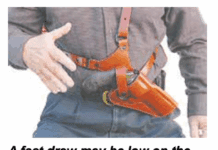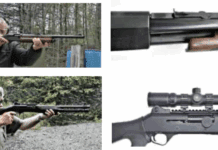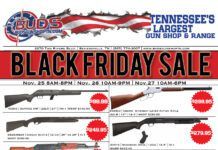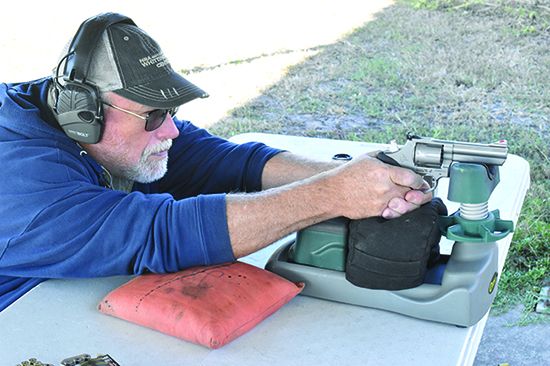Some shooters need one handgun to do everything — some self defense, some target plinking, a bit of small-animal hunting. We think that a mid-size, mid-weight, mid-price 357 Magnum revolver does a great job of filling those and other needs.
To that end, we are testing here three 357 Magnum revolvers with 4-inch barrels for overall utility. The first is the well-proven Ruger SP101 05771, $747. Made of stainless steel with a full-length underlug and a five-shot cylinder, it could be a great revolver to tote around in the woods. The second is the new Colt Viper SP4WRR, $970. Also in stainless steel with a 4.25-inch barrel, fixed sights, and nice walnut grips, the Viper sports a six-shot cylinder. Our last test piece is a Taurus Model 66 2-660049, $490. Available in blued or stainless steel, the Model 66 brings a heavy barrel, seven-round capacity, and great sights along with a very reasonable price.
To see what these wheelguns could do, we fired two 38 Special loads, Federal’s 110-grain Personal Defense rounds and Sellier & Bellot 148-grain wadcutters. To assess the top end of their power range, we also fired a 357 Magnum load, Winchester’s 158-grain jacketed hollow points. Here’s how the three revolvers performed.
Taurus Model 66 2-660049 357 Magnum
$490
Gun Tests grade: A- [BEST BUY]
The Taurus Model 66 was the easiest revolver in our lineup to shoot — no surprise because it was also the largest. Add in top honors for accuracy in this group, along with the lowest price, and we called it our winner. The shooter will have to decide if the extra weight and mass are issues
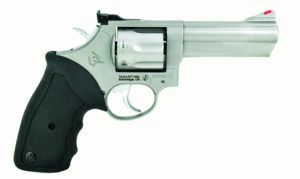
| Action Type | Revolver |
|---|---|
| Overall Length | 9.0 in. |
| Overall Height | 5.75 in. |
| Maximum Width | 1.5 in. |
| Weight Unloaded | 2.4 lbs. |
| Weight Loaded | 2.6 lbs. |
| Barrel Length | 4.0 in. |
| Barrel Material | Stainless steel |
| Frame Material | Stainless steel |
| Cylinder Material | Stainless steel |
| Grip Front Strap Height | 2.5 in. |
| Grip Back Strap Height | 4.5 in. |
| Grip Thickness (Maximum) | 1.125 in. |
| Grip Circumference | 5.25 in. |
| Capacity | 7 |
| Rear Sight | Adjustable |
| Front Sight | Red ramp insert |
| Sight Radius | 6.0 in. |
| Trigger Pull Weight (Double Action) | 9.9 lbs. |
| Trigger Pull Weight (Single Action) | 5.4 lbs. |
| Trigger Span | 3.5 in. |
| Safety | Transfer bar, manually keyed lock |
| Warranty | Limited lifetime |
| Telephone | (800) 327-3776 |
| Website | TaurusUSA.com |
| Made In | Brazil |
We’ve read that imitation is the sincerest from of flattery. If that is indeed the case, Smith & Wesson should be flattered by the Taurus Model 66. The S&W Model 66 is a stainless-steel medium frame six-shot revolver chambered in 357 Magnum. It has been a huge commercial and law-enforcement success for S&W. We think it is practical that Taurus should pursue some of that market with a similar product. The Taurus Model 66, however, is not just a rebranded clone of the S&W. Taurus has added some of its own DNA to the Model 66 product.
Our initial intent was to compare revolvers suitable for carry in exurban environments, much like the testing we have done for 10mm Autos over the last few years. That concept might seem to preclude anything but minimalist revolvers. Experimentation made us think otherwise. Our Taurus is larger than the Ruger or the Colt by about half a pound. We understand that ounces turn into pounds and pounds turn into pain on the trail, so only the shooter/hiker can decide whether convenience of carry is paramount. We thought that shootability might be another very real consideration for a packable piece.
Our Taurus Model 66 reminds us of a cross between a Smith & Wesson K frame and one of the L frames like the Model 686. The Taurus M66 uses a full-sized grip and a seven-shot cylinder, making it easier to control under recoil and extending the ammo supply by two shots over the Ruger and one round over the Colt. The one-piece finger-groove grips are thin and pebble grained. They cover the backstrap and help protect the middle finger of the strong hand from the trigger guard. The appearance of these grips says they are Hogue, but Taurus assures us that these are made in house. The trigger is wide and smooth, lending itself well to double-action shooting. The hammer is wide, checkered, and easy to cock. The 4-inch barrel has a full-length underlug, adding a good bit of weight to the front end. All the above made the Taurus a very comfortable revolver to shoot, even with full-house loads.
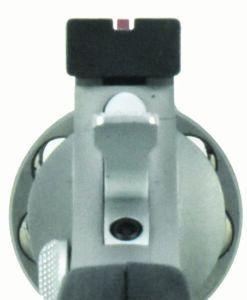
everything is topped off with highly visible adjustable sights.
We were very pleased with the action on the Taurus Model 66 — something we haven’t always been able to say about Taurus products in the past. Required trigger compression was 9.9 pounds double action and 5.4 pounds single action. Those numbers are not as light as the Colt, but they were still very manageable. The cylinder rotates, opens, and latches smoothly. There is an additional attachment latch at the top of the crane that locks into the frame. Everything is topped off with highly visible adjustable sights our shooters liked.
As with our other two test pistols, the Taurus utilizes a transfer-bar safety. The hammer never actually touches the firing pin. This piece of metal rests below the level of the firing pin and only extends upward when the hammer is drawn to the rear. It only remains extended, filling the gap between the hammer and the firing pin, if the trigger is held completely to the rear. The Taurus revolvers also offer a manual safety that is activated via turning a key in the back of the hammer. Firm believers in Murphy’s Law, we dislike features built into guns that can break then render them useless until mechanical correction is completed. We left the locks alone and everything worked fine.
The Taurus Model 66 was the most accurate of the three wheelguns in this test, averaging 1.25-inch groups across the board. It showed a preference for the 110-grain Personal Defense loads from Federal, compiling three groups with an average just a whisker over an inch. It also won the speed tests by a considerable margin. Split times — the time between shots — on the three-shot drills were 0.508 seconds for the Ruger (to bring the handgun back down out of recoil and execute an additional shot), 0.532 seconds for the Colt, and a very fast 0.318 seconds for the Taurus. The size of the Taurus helped, as it should. Only you can decide if this disqualifies it from proper consideration as a packing pistol. Add in a price that is two-thirds that of the Ruger and half that of the Colt, and we have our winner.
Our Team Said: The Taurus Model 66 was the easiest revolver in our lineup to shoot — no surprise since it was also the largest. Add in top honors for accuracy in this group along with the lowest price and we called it a Best Buy. Frankly, Taurus has had its ups and downs over the years. Then again, so have many other firearms manufacturers. After our recent review of the company’s new Expedition rifle and our time working with this Model 66, we wonder if all the hard work coming from new management in Brazil and the U.S. might be paying off for Taurus.
| 38 SPECIAL/357 MAGNUM RANGE DATA | |||
|---|---|---|---|
| Federal Personal Defense 38 Special 110-grain JHP | Colt Viper | Ruger SP101 | Taurus Model 66 |
| Average Velocity | 1009 fps | 912 fps | 929 fps |
| Muzzle Energy | 249 ft.-lbs. | 203 ft.-lbs. | 211 ft.-lbs. |
| Average Group | 1.80 in. | 1.27 in. | 0.93 in. |
| Best Group | 1.99 in. | 1.77 in. | 1.01 in. |
| Sellier & Bellot 38 Special 148-grain WC | Colt Viper | Ruger SP101 | Taurus Model 66 |
| Average Velocity | 684 fps | 617 fps | 644 fps |
| Muzzle Energy | 154 ft.-lbs. | 125 ft.-lbs. | 136 ft.-lbs. |
| Average Group | 0.76 in. | 1.72 in. | 1.28 in. |
| Best Group | 1.43 in. | 2.08 in. | 1.34 in. |
| Winchester Super-X 357 Magnum 158-grain JSP | Colt Viper | Ruger SP101 | Taurus Model 66 |
| Average Velocity | 1211 fps | 1137 fps | 1182 fps |
| Muzzle Energy | 514 ft.-lbs. | 454 ft.-lbs. | 490 ft lbs |
| Average Group | 1.51 in. | 1.67 in. | 1.28 in. |
| Best Group | 1.66 in. | 1.85 in. | 1.42 in. |
We tested at American Shooting Centers (AmericanShootingCenter.com) in Houston. We fired multiple five-shot groups at 15 yards. These revolvers were well-sandbagged in a Caldwell Pistolero Shooting Rest from Midway USA, No. 517357, $28, assisted by a Mini DRC Fortune Cookie from Wiebad.com (MINIFC, $75). We also fired additional one- and three-shot strings offhand to test for ease of handling and accuracy at full speed. We used a Garmin Xero C1 Pro ($599) to collect velocities. We used a CED7000 shot timer to collect elapsed times.
| DRILL NO. 1 DATA | |
|---|---|
| Pistol | Single Shot Average Time |
| Colt Viper | 0.85 |
| Ruger SP101 | 0.9 |
| Taurus Model 66 | 0.72 |
Process: Fire one shot from low ready at 3-by-5-inch card placed at 15 yards. Times in seconds are averages for five repetitions.
| DRILL NO. 2 DATA | |||
|---|---|---|---|
| Pistol | 1st Shot | Split Average | Total Time |
| Colt Viper | 0.85 | 0.294 | 1.44 |
| Ruger SP101 | 0.9 | 0.35 | 1.64 |
| Taurus Model 66 | 0.783 | 0.288 | 1.36 |
Process: Fire three shots from low ready at 3-by-5-inch card placed at 8 yards using 38 Special ammo. Times in seconds are averages for three repetitions.
| DRILL NO. 3 DATA | |||
|---|---|---|---|
| Pistol | 1st Shot | Split Average | Total Time |
| Colt Viper | 0.823 | 0.532 | 1.887 |
| Ruger SP101 | 0.87 | 0.508 | 1.887 |
| Taurus Model 66 | 0.753 | 0.318 | 1.118 |
Process: Fire three shots from low ready at 3-by-5-inch card placed at 8 yards using 357 Magnum ammo. Times in seconds are averages for three repetitions.
Written and photographed by Joe Woolley, using evaluations from Gun Tests Team members. GT



